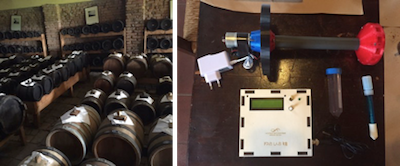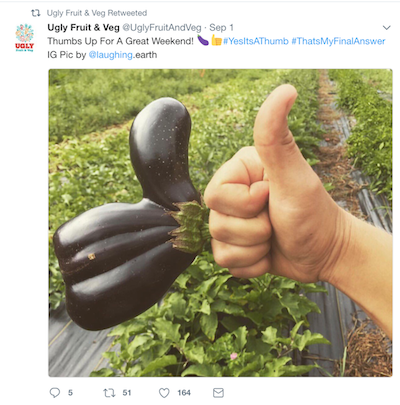Future Now
The IFTF Blog
Food Innovation Recipes: ENGAGED EATERS
Some recipes are passed down from generation to generation, becoming long-standing traditions. Others invite us to explore new regions or inspire us to reinvent our bodies. They even encourage us to reimagine the food spaces in our lives, from our kitchens to our marketplaces. The power of recipes is the power to combine ingredients in novel ways.
 As we look at the complex global threats we face over the coming decade, from environmental disasters to income inequality to political conflict, we must consider what Institute for the Future calls ingredients for change—capacities, tools, and platforms to reinvent food experiences with the greatest potential for transformation.
As we look at the complex global threats we face over the coming decade, from environmental disasters to income inequality to political conflict, we must consider what Institute for the Future calls ingredients for change—capacities, tools, and platforms to reinvent food experiences with the greatest potential for transformation.
This post gives an overview of one of these ingredients: engaged eaters. Read more about all five in our forecast report, Food Innovation: Recipes for the Next Decade.
ENGAGED EATERS:
Toward eater-led reinvention of the food system
What’s food innovation for, if not the eater? Providing food to satisfy a basic need of billions of people is the whole point of our global system of agricultural production, manufacturing, distribution, and shopping. In recent times, many eaters have been disconnected from how food is made, and efforts led by food companies and governments only incrementally changed ingredients or packaging. But eaters have lost trust in food companies and are once again getting engaged. By 2025, eaters will be much more than just the demand at the end of the supply chain. They will lead innovation that creates a food system rooted in values of sustainability, health, sociality, and pleasure.
Eaters have always been an important part of the innovation story. Today’s beloved food traditions are the result of innovations of the past—dreamed up by eaters who creatively used the technology at hand to meet a challenge, respond to a resource glut or constraint, or create a new flavor experience. During the past few decades, eaters demanded a food system that produced greater quantities of cheaper food— and with the help of industrial innovations, they got it. But now they are seeing the many trade-offs and limits of that system, and are demanding and creating change. Almost every major food company is responding to these engaged eaters by reducing antibiotic use, using natural colors and flavoring, and offering organics.
In the coming decade, engaged eaters will make more informed consumption choices, join in participatory production, and help to co-create foods. They will embrace new technologies, both to create fun, novel foods and to address urgent planetary-scale challenges. Rather than being passive consumers of convenient and delicious calories, engaged eaters will want to help address the complex connections between human health, economic mobility, environmental resilience, culinary heritage, and collective and personal identity. It’s a big ask, but the food industry is well positioned to help engaged eaters be a lever of change across all of those things.
We’ve developed three forecasts for how engaged eaters will unfold as an ingredient for innovation in the next decade, with signals of change from today.
FORECAST: informed consumption
From unreliable information to knowledgeable purchasing
Eaters today know they can’t always rely on their own five senses for accurate food information. Supermarket produce is big and shiny but often flavorless. Packaged foods are formulated with empty calories and addictive “bliss points.” Even ingredient labels are not always trustworthy. As engaged eaters take it upon themselves to fill regulatory gaps and search for transparency, they will be aided by technologies in, on, and around their bodies. Such devices will let them precisely measure their dietary needs, metabolic reactions to foods, and environments. Everyday objects with embedded sensing capabilities will also make a lot more data available to eaters at the point of consumption. And as new technologies make it easier to analyze food samples at the molecular level and make the data public, some eaters will gain new confidence in their buying choices. However, as more of this data comes from non-traditional food authorities, some of it will be highly contested.
 Signal: Edible electronics, like those being developed by materials science and biomedical engineers at Carnegie Mellon University, create a new way to observe the gut—to look for signs of infection, check out abnormal gastrointestinal activity, and study the microbiome. As such sensors become smaller and are equipped with nontoxic on-board power supplies, eaters will adopt them for an instant feedback loop about how food affects their bodies.
Signal: Edible electronics, like those being developed by materials science and biomedical engineers at Carnegie Mellon University, create a new way to observe the gut—to look for signs of infection, check out abnormal gastrointestinal activity, and study the microbiome. As such sensors become smaller and are equipped with nontoxic on-board power supplies, eaters will adopt them for an instant feedback loop about how food affects their bodies.
- Signal: A less invasive source of information will come from a wide range of handheld devices, such as these chopsticks, developed by Baidu, a Chinese search engine giant. They claim to measure the freshness of cooking oil and alert users to contaminated oil via a smartphone app. The chopsticks respond to food safety concerns in China, which has been rocked with scandals involving everything from toxic milk to glow- in-the-dark pork. These smart utensils put eaters in control of verifying a food’s quality and safety.
- Signal: Clear Food is a consumer initiative launched by Clear Labs. Monthly Clear Food reports, available to the public at no cost, help eaters identify the most high-quality foods based on molecular analysis. The first report, in October 2015, made headlines with test results that some vegetarian hot dogs contain human DNA. This garnered criticism as being misleading and highlighted the contested nature of new food authorities.
FORECAST: participatory production
From distant farms and factories to local makers
Whether in megacities in Southeast Asia, small towns in Italy, or suburbs in the United States, eaters will take a more active role in producing and processing their own food. Stemming from the same motivations as the maker movement, growing and cooking food is an empowering, engaging experience. Participatory production starts with kids, who are gaining basic food literacy through edible education curricula at school. As they learn to grow and cook food, their values shift and they see themselves as more than just consumers—and they will want to eat food that reflects this identity. Traditional practices, like small-scale farming or fermentation, will take on new precision with the help of sensors, and new conveniences with the help of automation technologies. Innovative food products are sure to emerge as eaters participate in producing foods they like, just as many of today’s successful craft beer brands started as home brewing projects.
Signal: Weekend farmers are a growing movement in Bengaluru, India. At the center of India’s high-tech industry, the city has seen a rise in working professionals heading out of the city on weekends to tend their organic farms. Driven by fears about industrial farming practices and a desire to connect their children to the land, this type of part-time farming might become more popular as urban populations increase.
 Signal: Blending tradition with food innovation, Acetaia San Giacomo, a traditional balsamic vinegar producer in Reggio Emilia, Italy, worked with the local Fab Lab to produce a vinegar kit that people can use to make vinegar at home. The kit features a 3D-printed, Arduino-powered pH sensor and aerator plus starter bacteria from Acetaia San Giacomo’s own barrels.
Signal: Blending tradition with food innovation, Acetaia San Giacomo, a traditional balsamic vinegar producer in Reggio Emilia, Italy, worked with the local Fab Lab to produce a vinegar kit that people can use to make vinegar at home. The kit features a 3D-printed, Arduino-powered pH sensor and aerator plus starter bacteria from Acetaia San Giacomo’s own barrels.
- Signal: Leaf, an automated at-home medicinal cannabis growing system, continuously monitors the growing environment and automatically makes adjustments to optimize plant health, while providing real-time environmental data via mobile. With its innovative nutrient dosing system and custom LED growlight, Leaf could provide a model for similar systems to grow produce at home.
FORECAST: co-created markets
From passive consumers to innovation allies
The traditional capital structures of the food industry are shifting, and thanks to co-creative financial arrangements, eaters are gaining more direct control over what food is produced and marketed. Companies are thinking of eaters as investors and collaborators as they consider how to embrace new technology and feedstocks while satisfying longstanding human desires for food to be delicious, nutritious, and social. New food brands are finding financial help from both the bottom up and the top down—innovative food projects have raised more than $70 million on Kickstarter, and billions of dollars in venture capital are pouring into food and agriculture technology. And established food brands are adapting their innovation strategies in response to political and economic pressure from engaged eaters. This new entrepreneurial ecosystem will create jobs, grow markets, and help eaters align their intentions with their actions.
Signal: The Exo Protein Bar, made from cricket flour, was originally developed with the financial backing of 1,241 people who pledged a total of $54,911 on Kickstarter. Engaging with early supporters, Exo could guarantee that what might seem like a risky product had a market before going into production. As crowdfunding and co-creation platforms grow, there will be more ways to engage eaters as partners.
 Signal: The Ugly Produce movement has been a very successful example of eaters creating new food markets. Global examples abound: French supermarket chain Intermarche launched a campaign to showcase the beauty of ugly produce, and the @UglyFruitAndVeg campaign in the United States has a large, active social media following, Imperfect Produce offers ugly produce CSA boxes. By crafting a fun and compelling narrative, this distributed group of activists is changing perceptions of imperfect fruits and vegetables, thereby reducing food waste and growing an entirely new market for once discarded foods.
Signal: The Ugly Produce movement has been a very successful example of eaters creating new food markets. Global examples abound: French supermarket chain Intermarche launched a campaign to showcase the beauty of ugly produce, and the @UglyFruitAndVeg campaign in the United States has a large, active social media following, Imperfect Produce offers ugly produce CSA boxes. By crafting a fun and compelling narrative, this distributed group of activists is changing perceptions of imperfect fruits and vegetables, thereby reducing food waste and growing an entirely new market for once discarded foods.
- Signal: General Mills’ new venture capital arm, 301 INC, is seeking emerging food brands that need capital to reach the next level. It aims to make direct equity investments and share expertise to grow small businesses and elevate their products. This partnership model represents a new kind of alliance for food innovation, leveraging the scale and resources of a large company and the fast- paced flexibility of a start-up.
 ARTIFACT FROM THE FUTURE: Incentivized Receipt
ARTIFACT FROM THE FUTURE: Incentivized Receipt
This particular Artifact from the Future might be something you would see over the coming decade as Engaged Eaters revolutionizes the food system. Read about what this image to the right is, and what it means for the future.
HOW WILL YOU CATALYZE FOOD INNOVATION?
Read all of the forecasts and foresight tools in our report, Food Innovation: Recipes for the Next Decade. It explores engaged eaters and four other ingredients for change—capacities, tools, and platforms to reinvent food experiences with the greatest potential for transformation.

Engaged Eaters are transforming our food system
Inspired by the engaged eaters we’ve encountered around the world, the Food Lab’s 2017 research is focused on Eating for Change and explores how a new generation of changemakers are using food as their medium for transformation. We conducted a global ethnographic study - from street food stalls in Shanghai to an okra farm in Georgia to a food-media production studio in Seoul to learn how people are using food to transform the world. In recent decades, we’ve seen an expansion in the diversity of demands—beyond price, taste, and convenience—we place on our foods. We’re looking to food to achieve transformation for our bodies, communities, and the planet. In the next decade, this desire and practice of using food as a lever for change will intersect with big global forces that will reshape the practices, choices, and tradeoffs of future eaters.
For More Information
For more information on the Food Futures Lab and its research, contact:
Rebecca Chesney | rchesney@iftf.org



